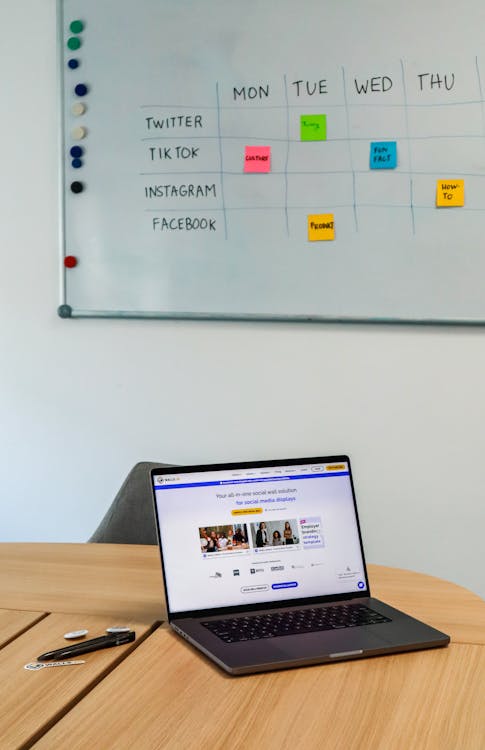Social Media Marketing for Small Businesses
Ever found yourself sitting on the couch at 10 PM, wondering what to post on Facebook tomorrow? One hand on your phone, the other juggling a mental to-do list—and still, no creative spark.
If you’re running a small business on your own, with no marketing team and barely any free time, this probably sounds familiar. The good news? You don’t have to be a content wizard to succeed on social media. With the right tools and strategy, you can show up consistently and start attracting new customers—even with a packed schedule.
Choosing the Right Platforms
Not every social media platform delivers the same results for every business. You don’t need to be everywhere — just be where your audience is:
- Ideal for visual industries like beauty, fitness, and wellness
- 44% of users look for product reviews and recommendations here [Hootsuite]
- Reels and Stories generate the highest engagement
- Perfect for building community through groups and events
- Used by 86% of marketers worldwide [SproutSocial]
- Easily integrates with booking systems like Timevise
- Great for building professional credibility and showcasing your expertise
- The top platform for B2B (business-to-business) service providers
X (Twitter)
- Best for following trends and sparking audience engagement
- Gen Z is the largest user group, growing by 12% since 2022 [Hootsuite]
- 49% of consumers make purchases at least monthly based on influencer content [SproutSocial]
Creating Effective Content
What Works Best?
Successful social media marketing is about creating content that resonates with your audience. The most effective content types are:
- Short videos – Most consumers prefer these to learn about products [SproutSocial]
- Customer reviews and testimonials – Build trust and credibility
- Behind-the-scenes content – Create a more personal connection
- Educational posts – Position you as a knowledgeable and reliable expert
- Team member introductions – Make your brand more relatable
- Exclusive promotions – Drive immediate action
Tip: Start with one content type (e.g., short videos or tip posts) and repurpose it across multiple platforms.
When to Post?
Consistency is more important than frequency. Research shows:
- Posting 3–4 times per week maintains engagement
- Ideal posting times vary by platform — use public stats as a guide
- Tailoring content to your audience’s habits boosts engagement

Automate as Much as Possible
Save time and stay consistent with automation tools:
- Use Buffer, Hootsuite, or Meta Business Suite to schedule posts in advance
- Set up automatic replies for frequently asked questions
- Track engagement to see what’s working
How Timevise Can Help
Integrating a booking system into your social media simplifies the scheduling process for clients. With Timevise, you can:
- Add “Book Now” buttons to your profiles (e.g., on Facebook)
- Share real-time availability updates
- Promote new services effortlessly
- Show clients how easy it is to book an appointment
Growing Your Follower Base
Once you’ve chosen your platforms and content, it’s time to focus on building a community. Community-building requires active participation.
Community-Building Tools
- Respond promptly to comments and messages
- Ask questions in your posts to spark conversations
- Create polls and surveys to gather feedback
- Share customer success stories and transformations
- Host Q&A sessions to understand future clients’ needs
Creative Content Ideas
Keep your content fresh and engaging. Try:
- Service highlights
- Industry news and trends
- Expert tips and tricks
Measuring Your Results
Always track your social media performance. Most platforms come with built-in analytics, and there are tried-and-true metrics to help evaluate your efforts.
Key Performance Indicators (KPIs)
These metrics help you measure impact objectively. Most commonly used:
- Engagement rate: 1.44%–2.31%, depending on industry [Hootsuite]
- Click-through rate (CTR): Varies by platform and content type
- Follower growth: Should be steady and organic
- Post reach: Aim to reach 25–30% of your audience
- Story views: Should reach 15–25% of your followers
- Response time: Aim to reply within 24 hours
Best Analytics Tools
These tools give valuable insights and help fine-tune your strategy:
- Platform analytics (Instagram Insights, Facebook Business Suite, LinkedIn Analytics)
- Social media management tools like SproutSocial
- Timevise booking analytics to monitor appointment trends
Social Media Best Practices
Do:
✔ Maintain a consistent brand presence across platforms
✔ Engage actively with comments and messages
✔ Post high-quality, authentic content
✔ Use clear calls to action (CTAs)
✔ Share high-resolution images and videos
Don’t:
✘ Don’t focus only on direct sales — build relationships
✘ Avoid divisive or controversial topics
✘ Never ignore negative feedback — handle it professionally
✘ Don’t buy followers — organic growth leads to real engagement
✘ Don’t post randomly or without a strategy
Summary
Social media marketing can be a powerful tool for small businesses — when done right. As 93% of marketers plan to maintain or increase video content investment in 2025 [SproutSocial], and global social media ad spending could reach $276.7 billion that same year, it’s clear digital engagement is growing.
By applying the strategies above, you can strengthen your online presence, boost client engagement, and generate more bookings. Start optimizing your social media strategy today and watch your business grow!
